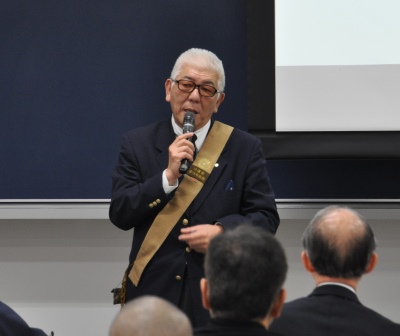2014 Level 1: Seminar 4
What Lurks Behind the Heart/Minds of the Young
November 19, 2014
Rev. Taido Kusuyama

Nichiren Denomination Priest & Director of the Young Person’s Mental Health
Consultation Center
At first sight, the youth of this contemporary age seem like “good kids”. But what is at the root of the problematic behavior of those troubled youth caught up in everything from social withdrawal (hikikomori) to involvement in destructive religious cults? This session will look at these issues from counseling work done on site with such young people.
Rev. Kusuyama has been a school teacher and school principal for over 30 years on the southern tip of the Tokyo urban sprawl in Kanagawa Prefecture, so he has a long experience with young people living in modern alienated society. Last year, he spoke at the Rinsho Buddhism Buddhism Chaplaincy Training Program Level 1 lecture series on his previous experience of the problems of young people getting caught up in cult religions. He says that more recently the cult issue is not as much of a problem, so he is looking more into alienation issues, like hikikomori in which young people shut themselves into their houses or bedrooms for extended periods.
His first and foremost point is that education nowadays in Japan just does not cultivate or raise children at all, and neither are their families or communities performing this role well. Thus, he questions who is or can do this? Buddhist priests and the temples? Rev. Kusuyama noted that back when the temples had a stronger influence in society, one didn’t see these issues much that are so prevalent today like cruelty (gyatai) and bullying (ijime) among kids. He feels this is because Buddhist ethics were still strong in society. Since Buddhist priests deal with birth, aging, sickness, and death, he feels they should naturally be involved in such problems as Buddhist chaplains.
From this standpoint, Rev. Kusuyama went into more detail on the present problems afflicting young Japanese people. The problem of school refusers (futoko) and shut-ins (hikikomori) begins to appear around 1975 in Japan, and now the number of hikikomori is estimated to be between 1-2 million people with 30% over the age of 30. The aging of the group is a real concern because the parents that have cared for these shut-ins over the years are dying and forcing these individuals to come out and deal with society after years of seclusion. A variety of other conditions are affecting Japanese youth like suicide, including group suicide over the internet; involvement in cults, with over 2 million youth being drawn into such groups; and indiscriminate murder, with perpetrators expressing sentiments such as, “I wanted to try killing someone.” and “Why shouldn’t I kill someone?” Rev. Kusuyama in his work has continued to ask experts why this is going on. Most have said that it’s unavoidable and just the way things are. He cannot accept such replies and feels religious professionals must address these problems.
Rev. Kusuyama feels that the root of these issues lies in the culture that developed in Japan during the period of great economic growth from the 1960s through the 80s. He feels there has been such a great shift in social values, which began placing ultimate importance on the pursuit of wealth as the means to happiness. Rev. Kusuyama feels that in this era, there has been a destruction of Japanese language, culture, and values, in which Buddhist culture and values are embedded. He feels modern, materialist culture is very dualistic?labeling things as black and white, friend or enemy, strong or weak, good or bad?to the point people become too reliant on external value systems and cannot understand things for themselves. The generation that emerged out of this era is one that he feels lacks any real sense of values, particularly values and norms for relating with others. There are numerous common expressions among young people nowadays that reflect this, like like, “Whatever” or “It doesn’t matter” (betsu-ni); “I’m not involved” or “I don’t care” (kankei-nai); and “I don’t know” (wakanai). Rev. Kusuyama feels the young have no feeling for existence and life, and this makes them an easy target for cult religious groups. Further, their parents and elders cannot understand why they don’t have a sense of drive and achievement like they did.
These kinds of relationship and personality disorders are prevalent in young Japanese, and Rev. Kusuyama gave a series of examples, such as a young man he knew who wanted to commit suicide after breaking up with a virtual girlfriend that he had created himself. He also noted that there has been a decrease in the number of young men getting involved in notorious motor cycle gangs, called bosozoku in Japanese. However, rather than being a sign of social health, he pointed out that this is a sign of the increased social withdrawal of young people. They cannot handle being in groups and cannot make friends, to the point of not even being able to form gangs! Rev. Kusuyama also recalled one time when he got a call from a parent who was excited that their child got arrested, because it showed he had gotten out and socialized.
This situation has also affected the kinds of activities, like children’s association, temples used to often be involved in. However, more proactive priests and temple communities have been reviving the traditional “temple school” (terakoya) and using it to take these kids out into nature and imbue them with traditional Buddhist values that stress human relationship. This will be the focus of Talk #6 in this lecture series by Prof. Masayuki Ikeda of the Kamakura Terakoya project. Rev. Kusuyama emphasized that temples that can move out to engage with society do still exist. This is an era, he feels, which is calling for religions to develop methods and ideas for reforming society, and this is what is needed from Buddhist temples today.

